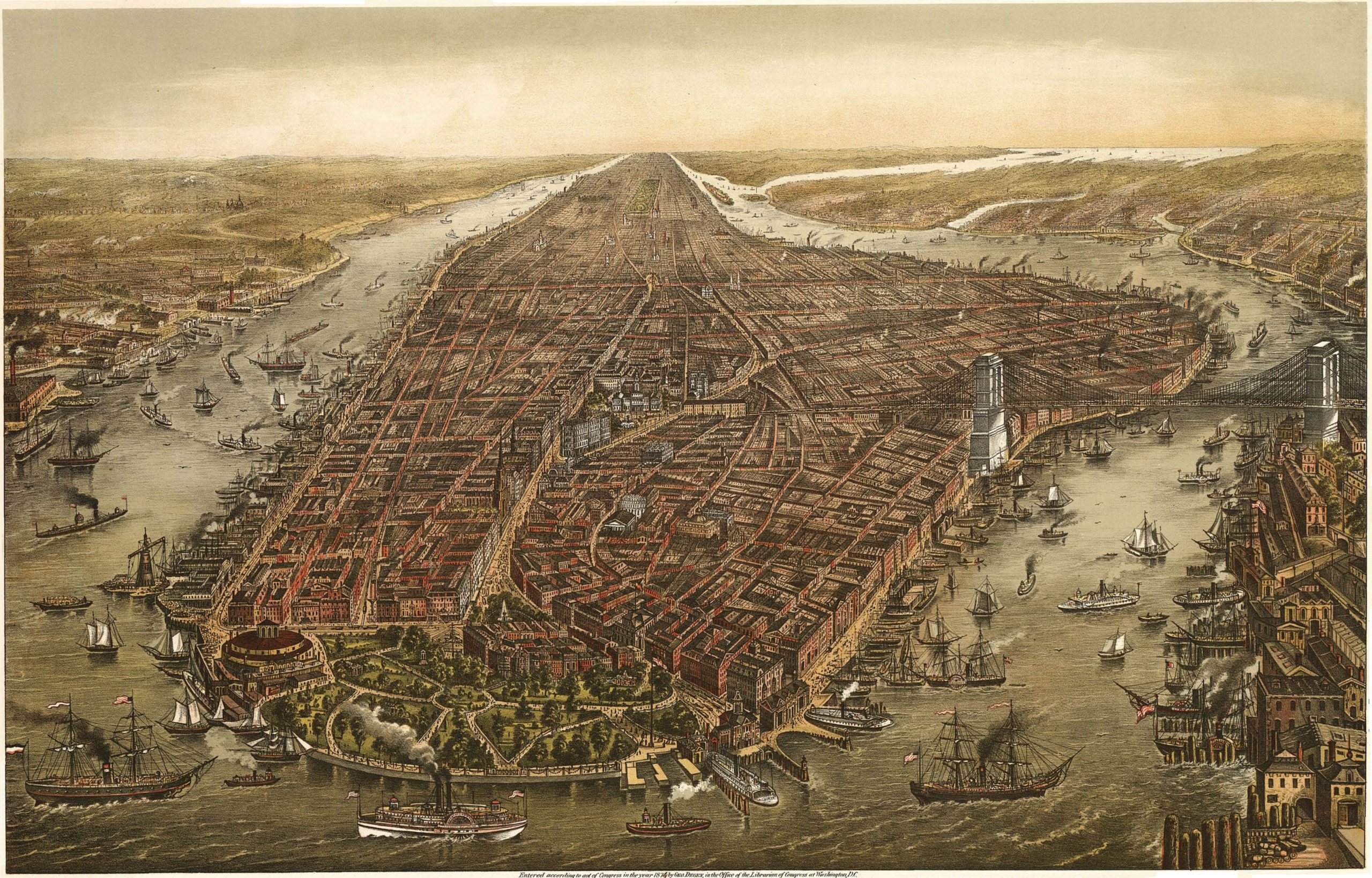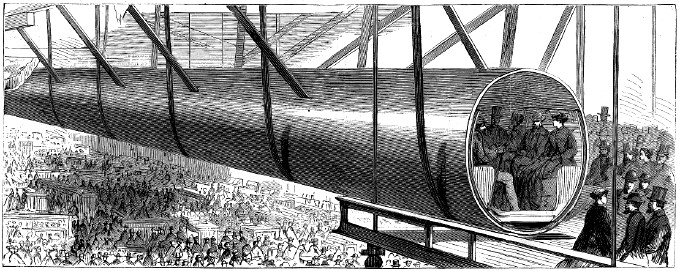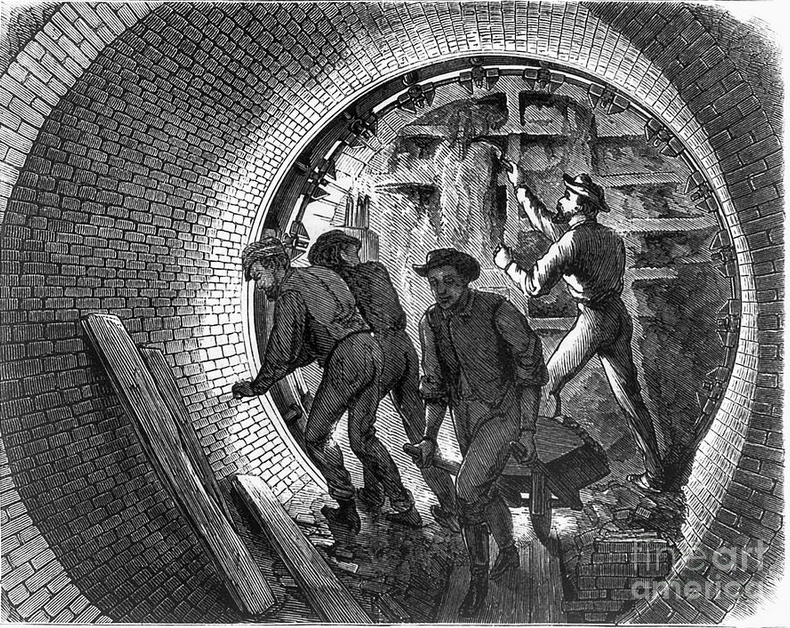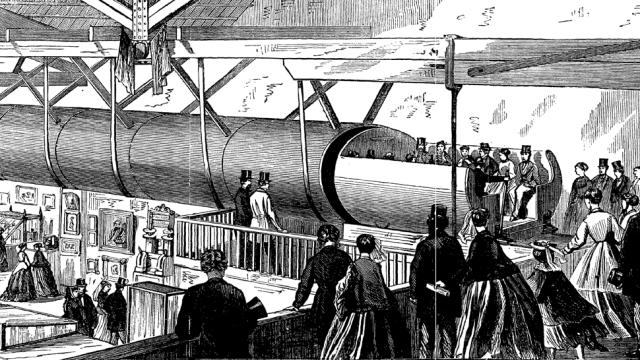Yesterday afternoon, Elon Musk revealed his plansfor a system that could revolutionise transit. This isn’t the first time a private entrepreneur has taken on transportation in America though. In fact, another wealthy businessman and inventor named Alfred Ely Beach attempted to do the same thing in New York, in 1869. Except instead of Hyperloops, he had pneumatic tubes.
Beach was the son of the wealthy owner of the New York Sun, and like his dad, he owned a publication: the then-young Scientific American. An inventor at heart, Beach patented all manner of ideas during his life, like a typewriter for the blind and an improvement to the cable car. But his most famous idea was the pneumatic subway. And while it’s novelty fodder for historians today, Beach’s idea had considerable traction in his own day — it even competed with the new-fangled elevator railway for funds.

New York in 1873. What a mess!
New York of the 1850s and 1860s was a nightmare to navigate: a rat’s nests of horse-drawn carriages, pedestrians, and delivery carts. Beach was interested in financing an alternative. His first idea was simple: Why not just build a second street, below the ground level, where horse-drawn streetcars could run unfettered? An alternative to animal power came from London, where the first underground subway was running on steam engines. Steam was clearly a better than horses — but Beach, perhaps through his work at Scientific American, had an even more radical plan in mind.
Beach’s idea, which he patented in 1865, was relatively simple — especially compared to Musk’s 54-page thesis (though they share some core tenets, surprisingly). It centred on an underground system of circular, brick-lined tubes, at the ends of which would stand high-powered fans. Air pressure from each end would push a streetcar back and forth along the line — much like the pneumatic tubes that were being used to transport mail in 1860s London and New York. In fact, 20 years earlier, British inventor George Medhurst had actually built a prototype of a similar contraption — which he christened (with considerably more flare) the Atmospheric Railway.

Beach’s prototype in 1867.
Being a man of means around the city, Beach was invited to test his idea at the American Institute Fair in 1867. In the fair’s grand hall he built a 30m long plywood version of his pneumatic subway, where visitors could go for rides in the airy hold of its carriage. At either end, a giant fan blew enough air through the tube that it could propel the 10-person car from one end of the track to the other with ease. The New York Times breathlessly called it “the most novel and attractive feature of the exhibition.”

In no small part thanks to his role in the publishing world, the idea began to gain traction. Beach successfully lobbied the infamous Boss Tweed, who ran New York on bribery and blackmail, to pass a bill allowing him to construct a system of pneumatic tubes and he got to work.
Crucially, he only requested permission to build tubes for transporting mail, not people. But in secret, he and his crew were building his dream — New York’s first gas-free, soot-free and electricity-free subway. They worked day and night to excavate a 90m tunnel from Broadway and Warren to Murray street and finally, through which they ran a 30-person pneumatic car powered by pressurised air from two massive fans. When the car reached one stop, the fans would change direction.

Workers dig the tunnel in secret.
After two years of secret subway-tunnelling, Beach took no chances unveiling his surprise to the public. According to one history, he built a 40m long waiting hall decorated with fine lamps, frescoes and a goldfish fountain, hoping that officials would be too charmed to object. The press, for their part, was enamoured (“Fashionable Reception Held In The Bowels Of The Earth,” reported the Post).

Image via MyNYC.
But, as they say, you can’t fight city hall — especially not Boss Tweed’s. When Beach went back to Albany to request funds to build a longer pneumatic line, Tweed introduced a similar bill — to build an elevated subway line. The governor’s plan won out. And within years, fewer people had reason to pay a quarter to ride Beach’s experiment. Soon, the space was converted for other uses and eventually, it was demolished to make way for the subway we know today.
In a way, Beach wanted the same thing as Musk: A clean, cheap, and technically brilliant solution to public transit. And interestingly, the key technical innovation of Musk’s plan — Kantrowitz limit, which dictates the behaviour of a pressurised tunnel — is one of the barriers that stood in the way of pneumatic subway tubes in the first place. Of course, it’s going to be tougher for Musk to built the Hyperloop in secret, and it’s not even clear that he’s interested in building it himself. But one lesson from Beach’s saga still rings true: No matter how brilliant your idea, try not to piss off the people with the money.
For an excellent history of pneumatic subways, check out Columbia professor Joseph Brennan’s thorough post on the subject, from which some of these images are drawn unless otherwise noted. Meanwhile, Untapped Cities has more information on where to look for evidence of Beach’s system.
